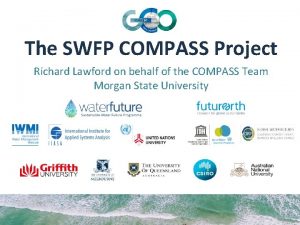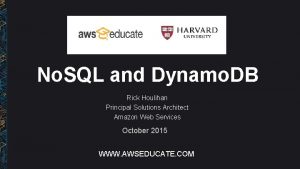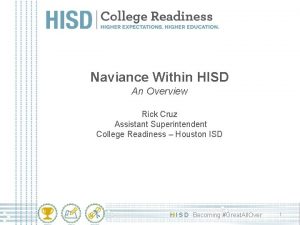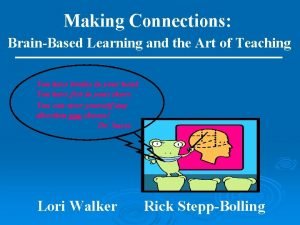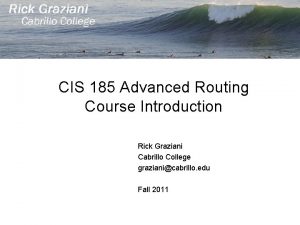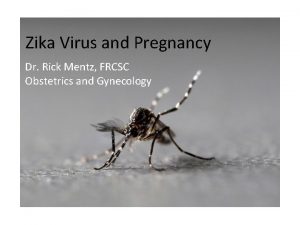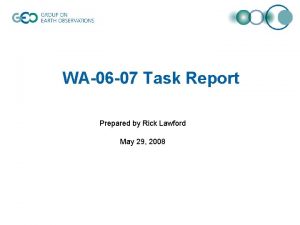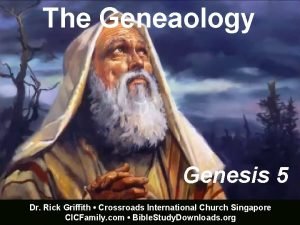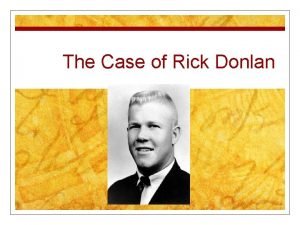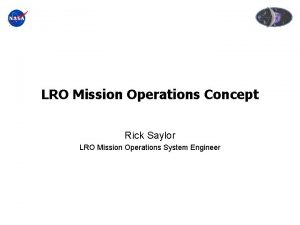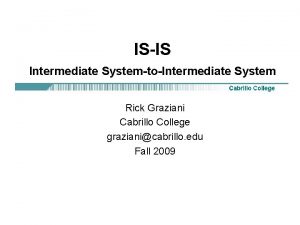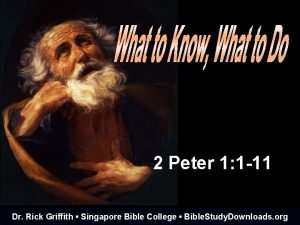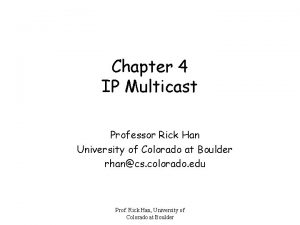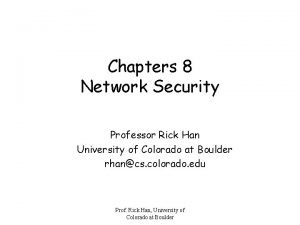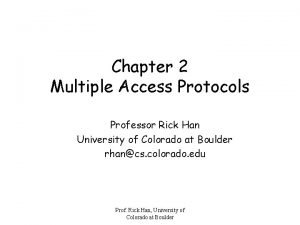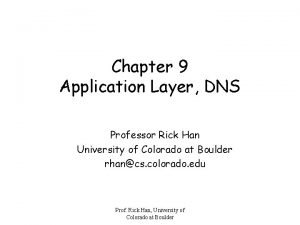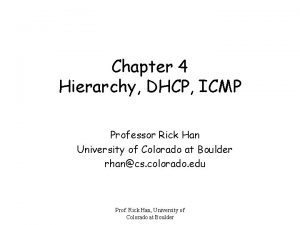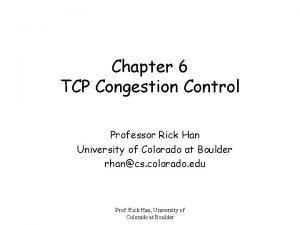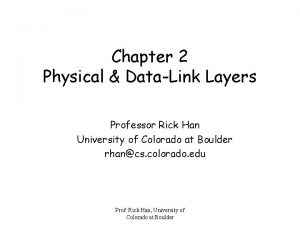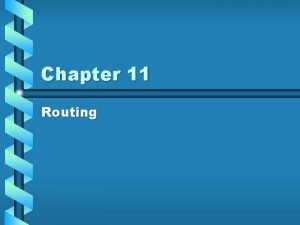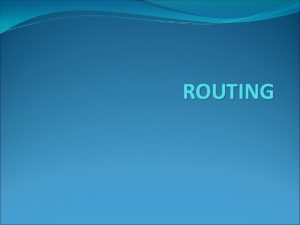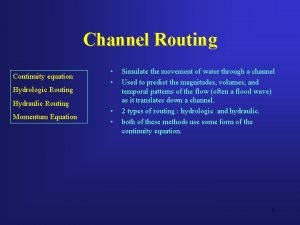Chapter 4 IP Routing Professor Rick Han University











































- Slides: 43

Chapter 4 IP Routing Professor Rick Han University of Colorado at Boulder rhan@cs. colorado. edu Prof. Rick Han, University of Colorado at Boulder

Announcements • Reminder: Programming assignment #1 is due Feb. 19 • Part of Homework #2 available on Web site, due Feb. 26 • Last week’s lecture are now on Web site • Next, IP routing, … Prof. Rick Han, University of Colorado at Boulder

Recap of Previous Lecture • Routing to connect remote LANs • Encapsulation • • • Connects Networks of Networks “Best-Effort” Service IP Packet Header – 20 bytes • TTL IP Addressing – 32 bit, heirarchy, 128. 72. 191. 4 IP Fragmentation and Reassembly Address Resolution Protocol (ARP) • Internet Protocol (IPv 4) • • • Prof. Rick Han, University of Colorado at Boulder

Address Resolution Protocol (ARP) • Given a known IP address, ARP returns the desired Ethernet MAC address • If sending to a host on the same Ethernet, • • First, check cache if address already present If not, send an Ethernet’s broadcast query (all 1’s in 48 -bit address) with “target IP” address • Target host responds with its IP address • ARP updates its cache Destination Node Eth. Header IP Hdr has dest. MAC ARP query ARP response Requesting Node Prof. Rick Han, University of Colorado at Boulder

ARP (2) • What if destination host is on a remote LAN? • No local host will respond to broadcast ARP query • IP end host sends to IP network, which routes packet to destination IP host ARP is performed separately on LAN 1 and LAN 2 • Solution: • IP Router LAN 1 LAN 2 Requesting Destination Node Prof. Rick Han, University of. Node Colorado at Boulder

• On LAN 1: • • • ARP (3) IP routers broadcast ICMP “router advertisements” on local LAN or impatient end host broadcasts “solicitations” When IP end host wants to send outside of LAN, it does ARP request to find MAC address of router’s IP interface address to LAN, if not already cached Sends a packet containing <src IP, dest. IP> encapsulated by Eth. Header containing dest. MAC address of IP router IP Router LAN 1 LAN 2 Requesting Destination Node Prof. Rick Han, University of. Node Colorado at Boulder

• On LAN 2: • • • ARP (4) IP packet with <src IP, dest IP> arrives at IP router on LAN 2 IP router does an ARP request to find MAC address of dest IP end host, if not already cached Sends a packet containing <src IP, dest. IP> encapsulated by Eth. Header containing dest. MAC address of dest IP end host • Proxy ARP when only one router between two LANs IP Router LAN 1 LAN 2 Requesting Destination Node Prof. Rick Han, University of. Node Colorado at Boulder

Forwarding Datagrams Routing Table at Router B Destination Host 1 Host 2 Host 3 Output Port X-B link E-B link D-B link Host 4 C-B link Router X Router B Router C Host 1 Router D Host 3 Prof. Rick Han, University of Colorado at Boulder Host 4 Router Y Router E Host 2

Forwarding Datagrams (2) Routing Table at Router E Destination Host 1 Host 2 Host 3 Output Port B-E link Y-E link D-E link Host 4 C-E link Router X Router B Router C Host 1 Router D Host 3 Prof. Rick Han, University of Colorado at Boulder Host 4 Router Y Router E Host 2

Forwarding Datagrams (3) Routing Table at Router E Destination Host 1 Host 2 Host 3 Output Port B-E link Y-E link D-E link Host 4 C-E link • Only need to know the destination address to route the datagram to output port. Compare to: • • VC routing tables had 4 columns: input VC, input port, output VC, output port Ethernet Bridge tables store the source address and source port/LAN, but forwards using destination address Prof. Rick Han, University of Colorado at Boulder

Forwarding Datagrams (4) Routing Table at Router E Destination Host 1 Host 2 Host 3 Output Port B-E link Y-E link D-E link Host 4 C-E link • Each datagram travels its own independent path: There is no connection unlike VCs • • “Connectionless” datagram networks “Connection-oriented” virtual circuits Prof. Rick Han, University of Colorado at Boulder

Forwarding Datagrams (5) Routing Table at Router E Destination Host 1 Host 2 Host 3 Output Port B-E link Y-E link D-E link Host 4 C-E link • Each routing table has to contain a complete list of all of the hosts on the net and how to get to them (next hop output port) • • Implications on scalability Compare to VC’s, where each switch only needed to keep in its table the virtual circuits that ran through the switch Prof. Rick Han, University of Colorado at Boulder

Internet Routing • “Routing” helps to fill in the IP forwarding tables • IP routing employs a distributed algorithm to calculated the shortest path through a graph • Many challenges to make distributed algorithms work well Homogeneous IP routing fabric Router X Host 1 Router B Router C Router D Prof. Rick Han, University of Colorado at Boulder Router Y Router E Host 2

Internet Routing (2) • • • Routing algorithms view the network as a graph Problem: find lowest cost path between two nodes. What info is required for solution? • • Need complete topology info Need link costs • Distance vector (RIP) Link state (OSPF) Two types of distributed algorithms: • Prof. Rick Han, University of Colorado at Boulder

Distance Vector (RIP) Employed in the early Arpanet • RIP = Routing Information Protocol • • A specific implementation of distance-vector routing Distributed next hop computation • Unit of information exchange • • • Vector of distances to destinations Distributed Bellman-Ford Algorithm Prof. Rick Han, University of Colorado at Boulder

Distance Vector (2) • Start Conditions: • Each router starts with a vector of distances to all directly attached networks • Send step: • Each router advertises its current vector to all neighboring routers • Receive step: • • Upon receiving vectors from each of its neighbors, router computes its own distance to each neighbor Then, for every network X, router finds that neighbor who is closer to X than any other neighbor Router updates its cost to X After doing this for all X, router goes to send step Prof. Rick Han, University of Colorado at Boulder

Distance Vector (3) • Example courtesy of Prof. Srini Seshan at CMU 1 B C 7 8 A 1 2 2 E D Distance to Node Info at Node A B C D E A 0 7 ~ ~ 1 B C 7 ~ 0 1 1 0 ~ 2 8 ~ D ~ ~ 2 0 2 E 1 8 ~ 2 0 Global minimum distance table, each row is a condensed forwarding Prof. Rick Han, University of table for node i Colorado at Boulder

Distance Vector (4) Format of Distance Table in A Dest. Node 7 A 1 Distance via Neighbor B C B E A -- -- B -- 8 -- 1 D E C Format of Routing/Forwarding Table in A Dest. at Node Distance Via Neighbor A -- B --- B C --- E B -- -- D -- B E-- -- E Prof. Rick Han, University of Colorado at Boulder

E Receives D’s Routes; Updates Cost Global minimum distance table, Node i only sees info on its row, not entire global view 1 B C 7 8 A 1 2 2 E D Distance to Node Info at Node A B C D E A 0 7 ~ ~ 1 B C 7 ~ 0 1 1 0 ~ 2 8 ~ D ~ ~ 2 0 2 E 1 8 4 2 0 Prof. Rick Han, University of Colorado at Boulder

A receives B’s; Updates Cost 1 B C 7 8 A 1 2 2 E D Distance to Node Info at Node A B C D E A 0 7 8 ~ 1 B C 7 ~ 0 1 1 0 ~ 2 8 ~ D ~ ~ 2 0 2 E 1 8 4 2 0 Prof. Rick Han, University of Colorado at Boulder

A receives E’s routes; Updates Costs For every dest. node X, router finds that neighbor who is closer to X than any other neighbor & updates its cost to X 1 B C 7 8 A 1 2 2 E D Distance to Node Info at Node A B C D E A 0 7 5 3 1 B C 7 ~ 0 1 1 0 ~ 2 8 ~ D ~ ~ 2 0 2 E 1 8 4 2 0 Prof. Rick Han, University of Colorado at Boulder

Final Distances • Topology/distance info ripples outward from each node from every other node 1 B C 7 8 A 1 2 2 E D Distance to Node Info at Node A B C D E A 0 6 5 3 1 B C 6 5 0 1 1 0 3 2 5 4 D 3 3 2 0 2 E 1 5 4 2 0 Prof. Rick Han, University of Colorado at Boulder

Link Failure Causes “Bouncing” Effect dest B C cost via 1 2 B B dest 1 X A A C B 1 25 C dest A B Prof. Rick Han, University of Colorado at Boulder cost via 2 1 B B cost via 1 1 A C

B Notices A-B Link Failure dest B C B notices failure, resets cost via A to infinity in distance table (not shown), & knows cost via C is 26 cost via 1 2 B B dest A A C B 1 25 C dest A B Prof. Rick Han, University of Colorado at Boulder cost via 2 1 B B cost via 26 1 C C

C Sends Dist. Vector to B dest B C cost via 1 2 B B dest A A C B 1 25 C dest A B Prof. Rick Han, University of Colorado at Boulder cost via 3 1 C sends routing update to B cost via 2 1 B B C C

B Updates Distance to A dest B C cost via 1 2 B B dest A A C B 1 25 C dest A B Prof. Rick Han, University of Colorado at Boulder cost via 3 C 1 C Packet sent from C to A bounces between C and B cost via until TTL=0! 2 1 B B

B Sends Dist. Vector to C dest B C cost via 1 2 B B dest A B 1 25 C dest A B Prof. Rick Han, University of Colorado at Boulder A C cost via 3 C 1 C C adds one to B’s advertised distance to A. (Why does C cost via override 4 B its stored 1 B distance of 2 to A with 4, larger value? )

C Sends Dist. Vector to B dest B C cost via 1 2 B B dest A B 25 C A C cost via 5 C 1 C B adds one to C’s 1 advertised distance to A. (overrides its stored dest cost via distance of 3 A 4 to A with 5, B B 1 B larger value) Prof. Rick Han, University of Colorado at Boulder

Link Failure: Bad News Travels Slowly dest B C cost via 26 25 C C dest A A C B Assume A has advertised C its link cost of 25 to C during B<->C exchanges. C stores this cost in its distance table (not shown) dest A B Prof. Rick Han, University of Colorado at Boulder 25 C 1 C After 20+ exchanges, routing tables look like this: 1 25 cost via 24 1 B B

Bad News Travels Slowly (2) dest B C cost via 26 25 C C dest A A C B 25 C cost via 25 C 1 C C increments B’s 1 update by 1, and chooses 25 via A to A, instead of 26 dest cost via Via B to A A B Prof. Rick Han, University of Colorado at Boulder 25 A 1 B

Bad News Travels Slowly (3) dest B C cost via 26 25 C C dest A A C B C dest A B Prof. Rick Han, University of Colorado at Boulder 26 C 1 C After 25 B-C exchanges, finally converge to stable routing 1 25 cost via 25 A 1 B

Link Failure Causes “Counting to Infinity” Effect dest B C cost via 1 2 B B dest 1 X A A C B 1 25 C dest A B Prof. Rick Han, University of Colorado at Boulder cost via 2 1 B B cost via 1 1 A C

B Notices A-B Link Failure dest B C B notices failure, resets cost to 26 cost via 1 2 B B A dest A C B 1 25 C dest A B Prof. Rick Han, University of Colorado at Boulder cost via 2 1 B B cost via 26 1 C C

C Sends Dist. Vector to B dest B C cost via 1 2 B B dest A A C B 1 25 C dest A B Prof. Rick Han, University of Colorado at Boulder cost via 3 C 1 C C sends routing update to B cost via 2 1 B B

A-C Link Fails dest A A C B C detects link to A has failed, but no change in C’s routing table (why? ) 1 C dest A B Prof. Rick Han, University of Colorado at Boulder cost via 2 1 B B cost via 3 C 1 C

Now, B and C Count to Infinity dest A A C B 1 C dest A B Prof. Rick Han, University of Colorado at Boulder cost via 4 1 B B cost via 3 C 1 C

How are These Loops Caused? • Observation 1: – B’s metric increases • Observation 2: – C picks B as next hop to A – But, the implicit path from C to A includes itself (C ) ! Prof. Rick Han, University of Colorado at Boulder

Solution 1: Holddowns • If metric increases, delay propagating information – In our example, B delays advertising route – C eventually thinks B’s route is gone, picks its own route – B then selects C as next hop • Adversely affects convergence from failures Prof. Rick Han, University of Colorado at Boulder

Other “Solutions” • Split horizon – C does not advertise route to B when it sends its distance vector • Poisoned reverse – C advertises route to B with infinite distance in its distance vector • Works for two node loops – Does not work for loops with more nodes Prof. Rick Han, University of Colorado at Boulder

Avoiding the Counting to Infinity Effect • Select loop-free paths • One way of doing this: – Each route advertisement carries entire path – If a router sees itself in path, it rejects the route • BGP does it this way • Space proportional to diameter Prof. Rick Han, University of Colorado at Boulder

Loop Freedom at Every Instant? • Does bouncing effect avoid loops? – No! Transient loops are still possible – Why? Because implicit path information may be stale – See this in BGP convergence • Only way to fix this – Ensure that you have up-to-date information by explicitly querying Prof. Rick Han, University of Colorado at Boulder

Distance Vector in Practice • RIP and RIP 2 – Uses split-horizon/poison reverse • BGP – Propagates entire path – Path also used for effecting policies Prof. Rick Han, University of Colorado at Boulder

Example Where Split Horizon Fails 1 A 1 1 C X 1 D B • When link breaks, C marks D as unreachable and reports that to A and B • Suppose A learns it first – A now thinks best path to D is through B – A reports D unreachable to B and a route of cost=3 to C • C thinks D is reachable through A at cost 4 and reports that to B • B reports a cost 5 to A who reports new cost to C • etc. . . Prof. Rick Han, University of Colorado at Boulder
 Goodrich method flood routing
Goodrich method flood routing Mark tinka
Mark tinka Hydrologic routing and hydraulic routing
Hydrologic routing and hydraulic routing Difference between clock routing and power routing
Difference between clock routing and power routing Promotion from associate professor to professor
Promotion from associate professor to professor How to read literature like a professor chapter 17
How to read literature like a professor chapter 17 How to read literature like a professor chapter titles
How to read literature like a professor chapter titles How to read literature like a professor chapter 5
How to read literature like a professor chapter 5 How to read literature like a professor flights of fancy
How to read literature like a professor flights of fancy How to read literature like a professor chapter 2
How to read literature like a professor chapter 2 Singapore bible college
Singapore bible college Rick lawford
Rick lawford Rick snodgrass
Rick snodgrass When was rick riordan born
When was rick riordan born Andreas gohritz
Andreas gohritz Rick trebino lectures
Rick trebino lectures Rick houlihan
Rick houlihan Rick cruz hisd
Rick cruz hisd Rick stepp san antonio
Rick stepp san antonio Rick domingo alaska airlines
Rick domingo alaska airlines Dr rick griffith
Dr rick griffith Rick graziani cabrillo college
Rick graziani cabrillo college Dr rick griffith
Dr rick griffith Rick mentz
Rick mentz Rick malter
Rick malter Paulsen
Paulsen Rick lawford
Rick lawford Dr rick griffith
Dr rick griffith Rick donlan
Rick donlan Rick bhugtana
Rick bhugtana Verseed
Verseed Rick benson iris
Rick benson iris Richard russell rick riordan jr
Richard russell rick riordan jr Rick strohmaier contact info
Rick strohmaier contact info Dr rick mentz
Dr rick mentz Rick warren class 201 pdf
Rick warren class 201 pdf Rick saylor
Rick saylor Rick bhugtana
Rick bhugtana Rick graziani ucsc
Rick graziani ucsc Dr rick griffith
Dr rick griffith Rick evers
Rick evers Dr rick griffith
Dr rick griffith Rick antle yale
Rick antle yale Rick kenney md
Rick kenney md











